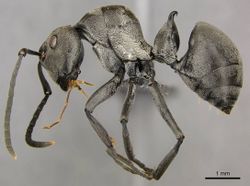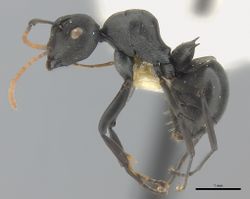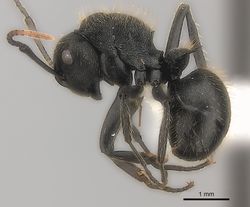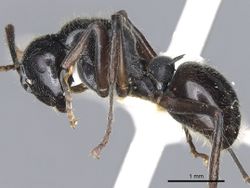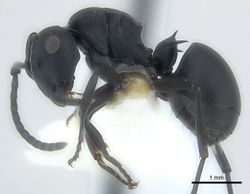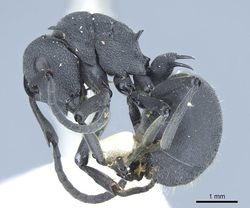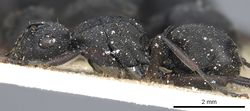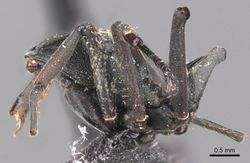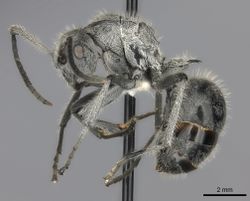Key to Afrotropical Polyrhachis species
This key workers of Afrotropical Polyrhachis is based on Rigato (2016) as modified by Taylor & McGavin (2020).
You may also be interested in
- Polyrhachis
- Myrma
- Key to Afrotropical Polyrhachis species-groups
- Identification resources for Afrotropical Ants
1
- Anterior clypeal margin with a median, shallow, rectangular lobe. Eyes usually situated well up on the head and not breaking the outline of the sides in full-face view. Mesosoma short, usually not more than 1.1 times longer than broad, with a swollen appearance and a long, very steep propodeal declivity. Pronotum, at least partially, marginate; propodeal dorsum unarmed => 2
- Anterior clypeal margin either arcuate or with a median, shallow lobe. Eyes breaking the outline of the sides of the head in full-face view except when the eyes are flat. Mesosoma more elongate, usually more than 1.3 times longer than broad, without a long, very steep propodeal declivity. Pronotum sometimes immarginate; propodeal dorsum usually armed with spines, teeth, tubercles or ridges => 6
2
return to couplet #1
3
return to couplet #2
- Petiole in frontal view with two dorsolateral long spines, curved backwards and somewhat outwards at their apices, so that the whole petiole is lyre-shaped. Propodeum without a posterior transverse margination separating the dorsum from the declivity. (West and central Africa) => Polyrhachis curta
- Petiole in frontal view with a pair of small triangular teeth. Propodeum usually with a weak posterior transverse margination separating the dorsum from the declivity. (Ghana, Rep. of the Congo, Central African Rep., Kenya) => Polyrhachis lestoni
4
return to couplet #2
- Propodeum immarginate, so that the dorsum rounds into the sides and declivity without interruption. (Dem. Rep. of the Congo, Central African Rep.) => Polyrhachis alexisi
- Propodeum marginate laterally and posteriorly, so that the dorsum is separated from the sides and declivity => 5
5
return to couplet #4
- In dorsal view propodeal sides project strongly beyond the lateral marginations so that the total width of the propodeum is notably greater than the width between the marginations. In full-face view head trapezoidal, with distinct posterior corners and anteriorly convergent, somewhat straight sides. Eyes distant from the head sides. (Ghana, Rep. of the Congo) => Polyrhachis latharis
- In dorsal view propodeal sides hardly projecting beyond the lateral marginations so that the total width of the propodeum is bounded, at least posteriorly, by the marginations. In full-face view head mostly oval, with less pronounced posterior corners and weakly convex sides. Eyes slightly interrupting the head outline. (Dem. Rep. of the Congo, Tanzania) => Polyrhachis limitis
6
return to couplet #1
- Pronotum immarginate, the dorsum curving smoothly and without interruption into the sides; rarely a trace of margination may appear anteriorly just behind the pronotal teeth => 7
- Pronotum distinctly marginate at least for part of its length, usually throughout its entire length; if the margination is weak, it runs along most of the pronotal sides, petering out posteriorly => 19
7
return to couplet #6
- Dorsum of mesosoma without erect hairs. Mesoscutellum visible on dorsum of mesosoma. (South Africa: Natal) => Polyrhachis gamaii
- Dorsum of mesosoma with erect hairs. Mesoscutellum not visible on dorsum of mesosoma (West and Central Africa) => 8
8
return to couplet #7
- Metanotal groove broad and deeply impressed. Propodeum armed with a pair of long upcurved spines, as long or longer than those of the pronotum. Petiole with four long, back-curved spines. Dorsum of mesosoma with numerous stout hairs => 9
- Metanotal groove neither broad nor deeply impressed, usually only represented by a line breaking the sculpturation. Propodeum unarmed or with a pair of tubercles, teeth or ridges which are notably smaller than those of the pronotum. Petiole with a dorsal pair of spines and a lateral pair of teeth or shorter spines. Dorsum of mesosoma with fine hairs => 10
9
return to couplet #8
- Promesonotal suture broad and deeply impressed. Propodeum without a median tuberculiform prominence between the spines. (West and Central Africa) => Polyrhachis monista
- Promesonotal suture narrow, hardly impressed. Propodeum with a median tuberculiform prominence between the spines. (Ghana, Dem. Rep. of the Congo, Central African Rep.) => Polyrhachis spitteleri
10
return to couplet #8
- Eyes flat and somewhat sunk into the head surface. Metanotal suture stronger than the promesonotal one. (Cameroun) => Polyrhachis platyomma
- Eyes convex, not sunk into the head surface. Metanotal suture weaker than the promesonotal one => 11
11
return to couplet #10
- Pronotal dorsum always with at least moderately raised sculpturation, usually dull => 12
- Pronotal dorsum at most superficially reticulate, smooth and shining => 17
12
return to couplet #11
- Propodeum unarmed posteriorly, the dorsum and the declivity very weakly separated. Longest hairs on tibiae much longer than the maximum tibial width. (Cameroun, Rep. of the Congo) => Polyrhachis longiseta
- Propodeum usually armed posteriorly either with a pair of transverse ridges (sometimes very weak) or with a pair of short upcurved teeth separating the dorsum from the declivity. If propodeal ridges absent, then hairs on tibiae at most hardly as long as the maximum tibial width => 13
13
return to couplet #12
- Median portion of clypeus projecting anteriorly as a truncated rectangular lobe => 14
- Median portion of clypeus arcuate and entire, without a truncated rectangular lobe => 15
14
return to couplet #13
- Propodeum in dorsal view distinctly longer than wide. Longest standing hairs on tibiae about as long as the maximum tibial width. (Democratic Republic of the Congo) => Polyrhachis kohli
- Propodeum in dorsal view slightly wider than long. Longest standing hairs on tibiae about as long as half the maximum tibial width. (Republic of the Congo, Democratic Republic of the Congo) => Polyrhachis volkarti
15
return to couplet #13
- Propodeum armed posteriorly with a pair of short upcurved teeth, between which the dorsum curves into the declivity. (Wide-spread in sub-Saharan Africa) => Polyrhachis weissi
- Propodeum armed posteriorly with a pair of transverse ridges separating the dorsum from the declivity; the ridges not meeting medially and sometimes very weak => 16
16
return to couplet #15
- Head and dorsum of mesosoma mostly longitudinally rugulose. The whole body appearing matte. Pubescence on the gaster long: each element much longer than the distance separating adjacent ones. Propodeal ridges and pronotal teeth distinct. (Cameroun, Congo) => Polyrhachis lanuginosa
- Head and dorsum of mesosoma irregularly sculptured, longitudinal rugulation at most ill-defined. Head and mesosoma weakly, gaster distinctly, shining. Pubescence on the gaster relatively sparse and short: each element at most slightly longer than the distance separating adjacent ones. Propodeal ridges faint, pronotal teeth minute. (Cameroun) => Polyrhachis dubia
17
return to couplet #11
- Anterior clypeal margin arcuate and entire. A short longitudinal groove, terminating in a pit-like depression posteriorly, occurs close to each antennal insertion. (Ghana) => Polyrhachis braxa
- Anterior clypeal margin with a shallow rectangular lobe. No short longitudinal groove occurs close to each antennal insertion => 18
18
return to couplet #17
- Head distinctly more sculptured than the mesosoma. Dorsum of mesosoma without distinct sutures. Standing hairs very long and often sinuate. (Ghana) => Polyrhachis khepra
- Head about as smooth as the mesosoma. Dorsum of mesosoma with a distinct promesonotal and a weak metanotal suture. Standing hairs relatively short and never sinuate. (Cameroun) => Polyrhachis luteipes
19
return to couplet #6
- Metanotal groove never impressed, represented only by a line or an indistinct scoring across the dorsum of the mesosoma which may fail to break the sculpturation => 20
- Metanotal groove distinct, broad and always impressed; in profile often with the appearance of a V or U-shaped trench separating the mesonotum from the propodeum => 35
20
return to couplet #19
21
return to couplet #20
- Propodeal dorsum and declivity separated by a continuous, well developed ridge. Size large, HL > 2.50. (Tanzania) => Polyrhachis terminata
- Propodeal dorsum and declivity medially confluent, at most laterally separated by a pair of ridges. Size small, HL < 2.00 => 21
22
return to couplet #21
23
return to couplet #22
- Pronotal margination weak. Scape relatively longer, SI > 160. (Central African Rep.) => Polyrhachis submarginata
- Pronotal margination well developed. Scape relatively shorter, SI < 150 => 24
24
return to couplet #23
- Propodeum with a pair of transverse, well developed ridges between dorsum and declivity. Dorsum of mesonotum laterally smoothly rounding into the sides. (West and Central Africa) => Polyrhachis otleti
- Propodeum with a pair of minute teeth at the posterodorsal corners. Dorsum of mesonotum separated from sides by an obtuse angle. (Uganda) => Polyrhachis transiens
25
return to couplet #22
- Mid pair of petiolar spines more than twice as long as the tooth-like lateral pair. Many erect hairs on scapes that are much longer than maximum scape diameter. Tibiae and tarsi testaceous, basally piceous. (Ghana, Rep. of the Congo) => Polyrhachis regesa
- Mid pair of petiolar spines at most 1.5 times as long as the spiniform lateral pair. Few erect hairs on scapes, hardly longer than maximum scape diameter. Tibiae and tarsi piceous. (Gabon, Rep. of the Congo) => Polyrhachis brevipilosa
26
return to couplet #20
- Propodeum laterally immarginate; pronotum laterally very weakly marginate for about half of its length. Sculpturation every-where a fine superficial reticulation or reticulate-puncturation. (Cameroun) => Polyrhachis aenescens
- Propodeum laterally marginate; pronotum laterally marginate throughout its length. Sculpturation of mesosoma basically a fine reticulate-puncturation overlaid by longitudinal rugae or a loose rugoreticulum => 27
27
return to couplet #26
- Petiole bearing a pair of lateral spines and a pair of median teeth => 28
- Petiole bearing a pair of lateral and a pair of, often longer, dorsal spines => 30
28
return to couplet #27
- Apex of antennal scape strongly broadened and hood-like in dorsal view, concealing the base of the first funicular joint, which is proximally dorsoventrally flattened; eyes flat. (Savannah regions throughout Africa => Polyrhachis viscosa
- Apex of antennal scape not strongly broadened and hood-like, not concealing the base of the first funicular joint => 29
29
return to couplet #28
- Propodeal dorsum posterolaterally bearing a pair of relatively well-developed raised spines. Dorsum of propodeum curving evenly into the declivity. (Ghana, Uganda, Dem. Rep. of the Congo) => Polyrhachis nigrita
- Propodeal dorsum posteriorly bearing a median lobe and posterolaterally a pair of upturned small teeth. Dorsum of propodeum often separated from the declivity by a thin ridge. (East Africa, also known from Yemen in southern Arabian Peninsula) => Polyrhachis omissa
30
return to couplet #27
- First gastral tergite finely longitudinally striate; eyes weakly convex. (South Africa, Malawi) => Polyrhachis arnoldi
- First gastral tergite finely reticulate-punctate; eyes convex => 31
31
return to couplet #30
- Propodeum without a transverse raised ridge running between the spines or teeth and separating the dorsum from the declivity, the dorsum passing through an angle or curving directly into the declivity, median tooth or tubercle absent. (South Africa: Natal) => Polyrhachis durbanensis
- Propodeum with a transverse raised ridge running between the spines or teeth and separating the dorsum from the declivity, the ridge often raised into a tooth or tubercle medially => 32
32
return to couplet #31
- Head in full face view trapezoidal, with distinct, rounded posterior corners. Head and mesosoma regularly longitudinally rugulose. (Kenya, Tanzania) => Polyrhachis gibbula
- Head in full face view more or less oval, without distinct posterior corners. Head and mesosoma mostly reticulate-punctate, superimposed longitudinal rugulation usually weak and often more or less effaced => 33
33
return to couplet #32
- Posterior propodeal corners with small, upturned teeth, which are much smaller than the pronotal teeth. (Kenya, Tanzania) => Polyrhachis gerstaeckeri
- Posterior propodeal corners with well developed, more or less upturned spines, which are similar in size to pronotal teeth => 34
34
return to couplet #33
- Propodeum with a sharp transverse ridge and a pronounced medial spine; frons and vertex without standing hairs => Polyrhachis mkomaziae
- Propodeum with a weak transverse ridge and no more than a low triangular median process => 34A
34A
return to couplet #34
- Frons and vertex bearing some pairs of standing hairs. (South Africa, Mozambique, Somalia) => Polyrhachis wilmsi
- Frons and vertex without standing hairs. (South and East Africa) => Polyrhachis spinicola
35
return to couplet #19
36
return to couplet #35
- Petiolar spines subparallel, strongly hooked backward at their apices. Clypeus carinate; gastral pubescence usually golden. (West and Central Africa, Uganda, Angola) => Polyrhachis laboriosa
- Petiolar spines divergent, curving posteriorly along their length but not hooked apically. Clypeus ecarinate; gastral pubescence usually grey. (Dem. Rep. of the Congo, Angola, Zambia) => Polyrhachis wellmani
37
return to couplet #35
- Petiole with six spines or teeth. The smallest teeth behind the lateral spines may be reduced to blunt tubercles => 38
- Petiole with four spines or teeth. No teeth or tubercles behind the lateral pair => 39
38
return to couplet #37
- Eyes placed behind the midlength of head sides. Petiole with a median pair of teeth and laterally with a pair of spines, each one bearing posteriorly a small tooth. The latter may even be reduced to a blunt tubercle. (West and Central Africa to the western-most regions of Kenya and Tanzania) => Polyrhachis decemdentata
- Eyes placed slightly in front of midlength of head sides. Petiole with a median pair of teeth and laterally with two pairs of long spines of similar length placed one in front of the other. (Ghana, Cameroun, Rep. of the Congo, Tanzania) => Polyrhachis andrei
39
return to couplet #37
- In profile, propodeal dorsum forming a strongly rounded gibbosity clearly above the level of the mesonotum. In dorsal view propodeal dorsum about twice as wide as long => 40
- In profile, propodeal dorsum at most slightly above the level of the mesonotum. In dorsal view propodeal dorsum at most a little wider than long => 41
40
return to couplet #39
- Face on each side with a short, longitudinal, shallow groove terminating in a depression posteriorly and situated close to the outer margin of the antennal socket. Mesosomal sculpture weaker, finely longitudinally striolate. Mesosoma with sparse standing hairs on pronotum and mesonotum only, or, rarely, completely hairless. (West and Central Africa, Uganda) => Polyrhachis lauta
- Face on each side without a short, longitudinal, shallow groove terminating in a depression posteriorly. Mesosomal sculpture stronger, pro- and mesonotum longitudinally rugulose, propodeum transversely so. Mesosoma, including propodeum, with moderately abundant standing hairs. (West and Central Africa, Uganda) => Polyrhachis fissa
41
return to couplet #39
42
return to couplet #41
- The whole body and appendages densely coated with silvery pubescence. Size larger, HL > 2.00, HW > 1.55. (South and East Africa) => Polyrhachis schlueteri
- At most only the mesosoma with dense pubescence, which dorsally has a golden or brassy tinge. Size smaller, HL < 2.00, HW < 1.45 => 43
43
return to couplet #42
- Dorsum of mesosoma with long and dense pubescence, at least partially hiding the sculpturation => 44
- Dorsum of mesosoma with short and sparse pubescence, not hiding the sculpturation => 46
44
return to couplet #44
- Dorsum of head without standing hairs. In posterior view the side of the head at the ventral margin of the eye projecting laterally below the eye and forming a shield; in side view the ventral eye margin slightly concave, so that the eye is reniform. (West and Central Africa) => Polyrhachis concava
- Dorsum of head with a pair of standing hairs situated on the vertex at the level of the posterior margins of the eyes. If the hairs have been lost, then the site of their original insertion is marked by a pair of pits.Eyes of usual shape, round or oval, without any shield below => 45
45
return to couplet #44
- Eyes smaller, globose and prominent, round in profile. Antennal scape longer (SI > 170). (Ghana, Central African Rep.) => Polyrhachis decellei
- Eyes larger, somewhat elliptical in profile. Antennal scape shorter (SI < 170). (West Africa) => Polyrhachis esarata
46
return to couplet #43
- Dorsum of pronotum strongly transversely concave, the lateral marginations projecting as raised flanges. (Dem. Rep. of the Congo) => Polyrhachis aerope
- Dorsum of pronotum very shallowly concave to transversely convex, the lateral marginations not projecting as raised flanges => 47
47
return to couplet #46
- Sculpturation of head a fine, dense, reticulate-puncturation. Sides of the head below and in front of the eye, and the gena between the eye and the posteriorior clypeal margin with numerous more distinct pits, usually arranged in groups of three or four. Larger species, HL > 1.60. (West and Central Africa) => Polyrhachis alluaudi
- Sculpturation of head a fine, dense, reticulation; the sides of the head below and in front of the eye, and the gena between the eye and the posteriorior clypeal margin with the same sculpturation as the dorsum. Smaller species, HL < 1.30. (West and Central Africa, Uganda) => Polyrhachis rufipalpis
48
return to couplet #41
- Lateral pair of petiolar spines as long as, or even longer than the dorsal pair => 49
- Lateral pair of petiolar spines short, always notably shorter than the dorsal pair, often reduced to small teeth => 51
49
return to couplet #48
- Antennal scapes with numerous erect hairs. (Ghana) => Polyrhachis asomaningi
- Antennal scapes with appressed pubescence only => 50
50
return to couplet #49
- Lateral pair of petiolar spines enormously developed, horn-like and much larger than the dorsal pair, which is tooth-like. First gastral tergite superficially reticulate-punctate. (Dem. Rep. of the Congo) => Polyrhachis cornuta
- Lateral pair of petiolar spines not enormously developed and horn-like, only slightly longer than the dorsal pair. First gastral tergite strongly punctate and often appearing finely longitudinally rugulose. (Central African Rep., Tanzania, “Equatorial Africa”) => Polyrhachis phidias
51
return to couplet #48
- Propodeum immarginate. Entire body deeply and regularly striate, the spaces between the striae strongly convex, giving a ploughed appearance. This sculpturation V-shaped on the anterior propodeum, longitudinal on head and rest of mesosomal dorsum. (Ghana, Congo, Equat. Guinea) => Polyrhachis sulcata
- Propodeum marginate. Sculpturation not as above: strong striation, if present, occurring on head and mesosoma only; striae on gaster, if present, occur on the first gastral tergite only and are usually weak => 52
- NOTE (K. Gómez): Some samples of Polyrhachis latispina from Guinea present parallel longitudinal reticulation in all gaster tergites.
52
return to couplet #51
- Dorsum of propodeum separated from declivity by a strongly arched transverse, raised ridge running between the spines. Dorsum of head and mesosoma distinctly longitudinally rugose. (West and Central Africa, Uganda, Kenya, Tanzania) => Polyrhachis latispina
- Dorsum of propodeum not separated from declivity by an arched transverse ridge, the two surfaces confluent or separate by a weak, almost straight, ridge or by a distinct change of sculpturation. Dorsum of head and mesosoma usually with less strong sculpturation => 53
53
return to couplet #52
- Dorsum of mesosoma with erect hairs present only on the pronotum. Side of head between ventral border of eye and ventrolateral margin without erect hairs. Gaster highly polished, with a very fine, superficial reticulation, and with short, very diluted pubescence. (South and East Africa) => Polyrhachis gagates
- NOTE (K. Gómez): Some samples of P. schistacea with few setae can resemble P. gagates. They can be easily separated as P. gagates completely lack any erect setae on the scapes, while P. schistacea has many erect setae in the anterior edge of the scape.
- Dorsum of mesosoma with erect hairs present on all segments. Side of head between ventral border of eye and ventrolateral margin usually with erect hairs. Gaster usually dull, with a fine reticulate-punctate sculpturation, or sculpturation hidden by pubescence => 54
54
return to couplet #53
- Head in full-face view subrectangular, sides weakly convex, posterior corners always distinct as more or less obtuse angles. Behind each eye there is a blunt margination separating the head dorsum from the side => 55
- Head in full-face view oval or suboval, posteriorly usually forming a broad convexity with no or faint posterior corners. Behind each eye there is no margination: head dorsum and sides smoothly confluent => 56
55
return to couplet #54
- Smaller (HL < 2.30, WL < 3.20) and stouter. In profile, propodeal dorsum and declivity about equal in length. Distinctly less hairy: no standing hairs on appendages, petiole and on the head sides in front of the eyes. (Gabon) => Polyrhachis doudou
- Larger (HL > 2.30, WL > 3.30) and more slender. In profile, propodeal dorsum about twice as long as the declivity. Distinctly more hairy: standing hairs present, and usually abundant, on appendages, petiole and on the head sides in front of the eyes. (Forest regions throughout Africa) => Polyrhachis militaris
56
return to couplet #54
- Propodeal teeth spine-like, upturned and long, in profile often almost as long as the height of propodeal declivity => 57
- Propodeal teeth short, in profile much shorter than the height of propodeal declivity => 58
57
return to couplet #56
- Pubescence long, abundant, mostly hiding the sculpturation and, at least partially, golden. Standing hairs relatively short: the longest ones on scapes and tibiae at most as long as scapes’ and tibial width at midlength. Head and mesosoma at most finely longitudinally rugulose. (Widespread from West to East Africa) => Polyrhachis epinotalis
- Pubescence mostly inconspicuous and sparse. Standing hairs very long: the longest ones on scapes and tibiae about as long as thrice and twice scapes’ and tibial width at midlength respectively. Head and mesosoma mostly strongly longitudinally rugose. (Gabon) => Polyrhachis fisheri
58
return to couplet #56
- Pubescence greyish and short, not hiding the sculpturation. Mesosoma transversely nearly flat. Smaller and more slender, HW < 2.30, PW < 2.00. (Savannah regions throughout Africa) => Polyrhachis schistacea
- Pubescence silvery and long, often hiding the sculpturation. Mesosoma more transversely convex. Larger and stouter, HW > 2.30, PW > 2.20. (East Africa) => Polyrhachis medusa

